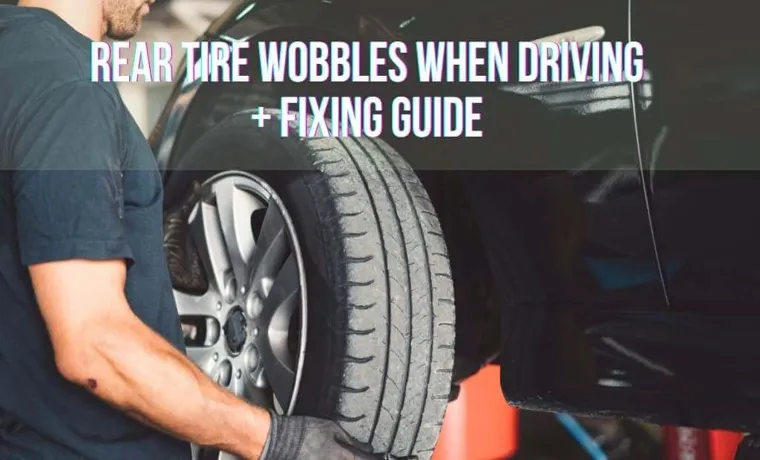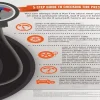Have you ever experienced a wobbling sensation from your car’s tires while driving? It’s no joke when your car starts to vibrate and shake, it can not only result in an uncomfortable driving experience but can also be dangerous. The root cause of this problem could be due to various factors, from worn-out suspension parts to unbalanced tires or even a bent rim. Regardless, it’s crucial to identify and address the issue before it results in further damage or a potential accident.
In this article, we’ll dive into the reasons why your tire may be wobbling while driving and discuss what steps you can take to fix the problem. So, buckle up and let’s get started!
Table of Contents
Possible Causes of Tire Wobbles
If you’re experiencing tire wobbles when driving, it’s important to find out what’s causing it as soon as possible. There are various reasons why your tires might wobble, but one possible cause could be imbalanced tires or wheels. Imbalanced tires could occur due to uneven wear, improper mounting, or a bent rim.
This could lead to an uneven distribution of weight, causing your car to shake or wobble. Another cause could be worn-out or damaged suspension components, such as tie rods or bushings. If your tires are not properly aligned, it could also cause instability when driving, resulting in a wobble.
Other causes could include tire damage or a broken belt. If you’re experiencing tire wobbles, it’s best to have your car checked by a professional mechanic to accurately diagnose and fix the issue.
Irregular Tire Wear
Possible Causes of Tire Wobbles: Irregular tire wear is a common problem that many drivers often encounter. Tire wobbles can occur when there is uneven wear on the tires, causing them to lose their balance and stability. One of the potential causes of tire wobbles is incorrect tire alignment.
Misaligned wheels can cause excessive wear on the tires, leading to disturbing vibrations and wobbles while you drive. Another potential cause is worn-out suspension components, such as shocks or struts, which can result in wobbling or shaking while driving. Additionally, tire wobbles can also be caused by worn steering components, such as ball joints or tie rods, that lead to an inaccurate steering response and unstable handling.
To prevent tire wobbles, it’s essential to have your tires regularly checked and professionally aligned, particularly after hitting a pothole or curb. Regular maintenance and inspections can help you avoid this problem and ensure your vehicle’s safety and stability on the road.

Imbalanced Tires
Imbalanced tires can cause a lot of problems for your vehicle. If you notice a wobble or vibration in your steering wheel or throughout the car, it may be due to imbalanced tires. This occurs when the weight of the tire is not evenly distributed across the tread.
The main cause of imbalanced tires is wear and tear. As the tread on your tires wears down, it can create an uneven distribution of weight. Poorly maintained or old tires can also cause issues with balance.
In extreme cases, it can even lead to dangerous situations on the road. To avoid these problems, it’s essential to have your tires balanced regularly. This means having a professional mechanic check the tires and redistribute the weight as necessary.
Regular tire rotation and replacement when necessary can also help prevent imbalanced tires. Remember, your tires are the only point of contact between your car and the road, so keeping them in top shape is essential for safety and performance.
Bent Wheels
If you’ve ever experienced a tire wobble while driving, you know how unsettling it can be. One possible cause of this issue is a bent wheel. A bent wheel can be caused by hitting a curb or pothole, or simply from normal wear and tear over time.
When a wheel is bent, it creates an uneven surface for the tire to roll on, which can cause it to wobble or vibrate. This can be dangerous, as it can lead to decreased stability and control while driving. If you suspect that you have a bent wheel, it’s important to get it checked out by a professional as soon as possible.
They can assess the damage and determine if the wheel can be repaired or needs to be replaced. By fixing the issue promptly, you’ll be able to ensure your safety on the road and prevent any further damage to your vehicle.
Worn-Out Steering Components
When it comes to tire wobbles, one of the possible causes you should look into is worn-out steering components. These components, which include tie rods, ball joints, and control arm bushings, play a vital role in maintaining the stability and effectiveness of your vehicle’s steering system. Over time, these parts can become corroded, cracked, or loose due to wear and tear, resulting in an unnerving vibration or shaking in your steering wheel.
If left unchecked, this issue can quickly escalate into a more significant safety concern, affecting your ability to control the vehicle. Therefore, it is crucial to get your steering components checked by a professional mechanic regularly. By doing so, you can ensure that your vehicle’s steering system functions correctly and help avoid any potential accidents on the road.
So, if you’re experiencing tire wobbles, don’t hesitate to schedule a comprehensive inspection with a trusted mechanic to identify and fix any underlying issues.
How to Diagnose the Problem
Are you experiencing a wobbling sensation in your vehicle when you are driving? If so, it is likely that your tires are the cause of the problem. Before you panic, there are a few things you can check to try to diagnose the issue. First, inspect your tires for any visible damage or deformities such as bulges, flat spots, or uneven wear.
If your tires look okay, check that they are balanced properly. An unbalanced tire can cause wobbling. You may also want to have the alignment checked to ensure that your tires are properly aligned.
If none of these things fix the issue, it’s best to bring your car to a professional mechanic who can further diagnose and repair the underlying issue. In any case, it’s important to address the problem as quickly as possible as driving with an unstable tire can be dangerous and lead to further damage.
Checking for Uneven Tire Wear
If you notice uneven wear on your tires, it’s often a warning sign that something is wrong. There are several ways to diagnose the problem. One way is to inspect your tires for any signs of abnormal wear patterns.
Look for uneven wear on the treads, as well as any bulges, cracks, or cuts on the tire surface. Additionally, inspect your suspension system, which can cause uneven wear if it’s not working properly. Have a professional inspect your suspension if you’re unsure.
Another potential issue could be an alignment problem. Misaligned wheels can cause one tire to wear down more quickly than the others. This is particularly common if you’ve hit a pothole or curb recently.
In any case, it’s important to address any tire wear issues promptly to avoid further damage or safety hazards on the road.
Getting Your Wheels Balanced
Getting your wheels balanced is essential to ensure a smooth and safe drive. If you are experiencing vibrations or shaking at high speeds, this could be a sign of an unbalanced wheel. In severe cases, it may even lead to uneven tread wear and tire damage, causing early replacement.
To diagnose the problem, start by inspecting your tires and wheels for any visible signs of damage. Then, take note of when the vibrations occur – if it is at a certain speed or during acceleration or braking. You may also notice a pulling or drifting to one side.
Once you have gathered this information, it’s time to take your car to a professional mechanic who can perform a balance and alignment check. They will use specialized equipment to identify any imbalances and make the necessary adjustments. By addressing the problem early on, you can prevent further damage to your vehicle and ensure a safe driving experience.
So, don’t hesitate to get your wheels balanced and enjoy a smoother ride on the road.
Inspecting Your Wheels for Damage
Inspecting your wheels for damage is an important task that every car owner should do regularly. One common issue that can arise is a bent or broken wheel. This can cause your car to shake or vibrate while driving and can even affect your steering.
To diagnose the problem, start by looking for any visible damage on the wheel. This may include dents or cracks in the rim, or any unusual bends or twists. You can also check for any damage to the tire itself, such as bald spots or bulges.
Another thing to look out for is any unusual noises or vibrations while driving. This could indicate an issue with your wheel bearings or suspension. By inspecting your wheels regularly, you can catch any damage early and prevent any further issues from occurring.
Examining Steering and Suspension Components
When it comes to steering and suspension components, diagnosing the problem can seem daunting. However, there are a few things to look out for that can help pinpoint the issue. For steering, if your vehicle is pulling to one side or if the steering wheel vibrates or feels loose, it could be a sign of worn out tie rods, steering rack, or ball joints.
On the other hand, suspension problems may present themselves as a bumpy or noisy ride, uneven tire wear, or a vehicle that leans to one side. These issues can be caused by worn shocks, struts, or springs. Sometimes, it can be difficult to determine the exact cause of the problem.
However, a thorough inspection of the components along with a test drive can provide helpful clues. By paying attention to these warning signs and addressing them promptly, you can ensure your vehicle’s steering and suspension remain in top-notch condition.
Preventing Future Tire Wobbles
Tire wobbles when driving can be a scary experience for any driver. The good news is that there are steps you can take to prevent them from happening in the future. First, make sure your tires are properly inflated to the manufacturer’s recommended pressure.
Over or underinflated tires can cause wobbling and other issues. You should also check your alignment and suspension regularly, as they can affect how your car handles and cause wobbling. Another important factor to consider is tire balance.
If your tires are unbalanced, they can cause uneven wear and ultimately wobbling. Finally, be mindful of the road conditions you’re driving on – potholes and other hazards can cause damage to your tires and their alignment. By taking these preventative measures, you can ensure a safer and smoother driving experience.
Regular Tire Maintenance
Regular tire maintenance is essential to keep your vehicle running smoothly and safely on the road. One common issue that can arise if you neglect tire maintenance is tire wobbles. These wobbles can cause discomfort while driving and can even be dangerous if not addressed promptly.
To prevent future tire wobbles, there are a few things you can do. Firstly, make sure to check your tire pressure regularly using a tire pressure gauge. Low tire pressure can cause uneven wear and tear on your tires, leading to wobbles.
Secondly, rotate your tires regularly to ensure that they wear evenly. This will help prevent wobbling caused by uneven wear. Lastly, make sure to get your wheels balanced regularly.
Unbalanced wheels can cause wobbles, which can be especially noticeable at higher speeds. By taking these simple steps, you can help prevent future tire wobbles and keep your vehicle running smoothly and safely.
Avoiding Potholes and Obstacles on the Road
When it comes to driving, encountering potholes or obstacles on the road can be frustrating and even dangerous. Not only can it damage your car, but hitting a pothole can cause your tires to wobble. In the future, there are a few things you can do to prevent this from happening.
Firstly, it’s important to keep an eye out for obstacles on the road and try to avoid them as much as possible. Secondly, make sure your tires are properly inflated and maintained. Over or under-inflated tires can increase the likelihood of wobbling.
Thirdly, slow down when driving over speed bumps or uneven surfaces. This will not only protect your car but also reduce the risk of your tires wobbling. By following these simple steps, you can avoid potholes and obstacles on the road and protect your tires from future wobbles.
Conclusion
In the end, a wobbly tire while driving is like a bad dance partner- it throws off your rhythm and makes for a bumpy ride. So make sure to keep those tires balanced and aligned, or else you might be in for one shaky situation!”
FAQs
Why does my tire wobble when I’m driving?
A tire wobble can be caused by a few different things, such as an unbalanced tire, a damaged wheel, or worn out suspension components. It’s best to have your vehicle inspected by a mechanic to determine the exact cause of the wobble.
Can driving on an unbalanced tire cause it to wobble?
Yes, an unbalanced tire can cause a wobble while driving. This happens when the weight is not distributed evenly around the tire, causing it to vibrate and wobble as you drive.
How can I tell if my tire is unbalanced?
Signs of an unbalanced tire include a wobbling sensation while driving, uneven wear on the tire tread, and steering wheel vibration at certain speeds. It’s important to have any of these symptoms inspected by a professional to ensure safety on the road.
Can a bent wheel cause my tire to wobble?
Yes, a bent or damaged wheel can cause a tire to wobble while driving. This is because the wheel is not perfectly round, causing the tire to move unevenly and creating a wobbling sensation.
Do worn suspension components cause tire wobble?
Yes, worn suspension components such as ball joints or tie rods can cause tire wobble while driving. This is because these components are responsible for keeping the tire and wheel aligned properly, and when they are worn, the wheel can become misaligned and cause a wobble.
Can driving on rough roads cause tire wobble?
Yes, driving on rough roads can cause your tire to wobble. This is because the rough surface can cause the tire to become unbalanced, or it can damage the suspension components that keep the tire and wheel aligned properly.
What should I do if my tire wobbles while driving?
If your tire wobbles while driving, it’s important to have it inspected by a professional mechanic as soon as possible. Driving with a wobbling tire can be dangerous and lead to further damage to your vehicle.



